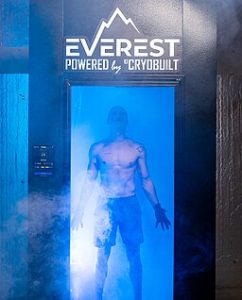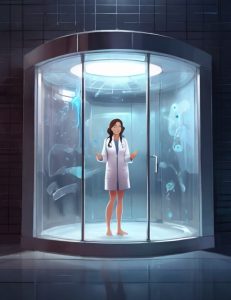Health and Medicine
102 Cryotherapy in Society
Karma Rini and Emma Volding
Introduction
Cryotherapy is a popular therapeutic method that has evolved from the use in ancient practices to modern, cutting-edge technologies used today. The growing use and popularity of different types of cryotherapy parallels the increasing societal demand for technology that betters one’s health. Cryotherapy has evolved over time from ice packs to cryosurgery to whole-body chambers as a result of increasing technological advancements, increased scientific research performed by society, and increased therapy practices in sports and wellness trends. Through the lens of the modernization theory, the evolution of cryotherapy can be viewed as a technology created by society in response to the culture that has been created over time pertaining to health, sports medicine, and aesthetics. This chapter dives into the ways cryotherapy has evolved with society as well as touches on the under looked biases of the technology itself.
Connection to STS

Cryotherapy reflects the convergence of science, technological innovation, and societal values regarding health and wellness. As advancements in cryotherapy research and technology emerge, the practice becomes increasingly accessible to the general public, catering to a growing societal interest in alternative health therapies and holistic well-being. The widespread adoption of cryotherapy centers and treatments reflects the cultural shift towards proactive self-care and the integration of innovative health technologies into daily life. The popularity of cryotherapy signifies the modern trend of embracing non-invasive, natural approaches to managing physical discomfort and enhancing overall vitality. Cryotherapy serves as a prime example of how the interplay between science, technology, and societal preferences shapes contemporary health practices and fitness trends.
Cryotherapy Technology
The basis of cryotherapy is that it forms a reduction in tissue temperature by withdrawal of heat from the body (Kwiecien & McHugh, 2021). The practice of heat reduction within the core body is physiologically seen as a benefit by slowing sensory nerve conduction velocities (Allan et.al., 2022). The basis behind cryotherapy is that the heat loss when applying extremely cool temperatures (between -110℃ to -140℃) occurs mainly at the skin. The heat lost at the skin-level represents the amount lost in metabolically active tissues (Cuttell, 2017). The change in blood flow and conduction velocities due to heat loss provides evidence to minimize the inflammatory response regarding injuries, post-exercise muscle recovery as well as treat skin conditions, cancerous lesions, and provide pain relief to those with rheumatoid arthritis, and ankylosing spondylitis (inflammatory arthritis of the spine) (Millhone, 2023).
Cryotherapy dates back to ancient Greece, where work by Hippocrates suggested that cold water therapy would prevent energy and strength depletion (Allan et. al., 2022). He became credited as the ‘grandfather of cryotherapy’ due to his connection of ice and snow to oedema treatment (Allan et. al., 2022). Since then, cryotherapy has been studied and utilized in greater context through cold-water immersions, ice application, and then cold-air application which led to the modern whole-body cryotherapy (WBC) chamber development. The first WBC chamber was built in Japan in 1978 by Dr. Toshima Yamaguchi (Allan et.al., 2022). Dr. Yamaguchi studied the effectiveness of the chamber on pain relief and endorphin release, where he found that 80% of his patients were relieved of pain symptoms following the therapy (Allan et.al., 2022). Today, WBC is often used in exercise recovery for professional athletes as well as a newer form of partial-body cryotherapy (PBC) that allows the head and neck to remain outside of the chamber while the rest of the body is exposed to cold temperatures (Allan et.al., 2022). This method of cryotherapy is the most popular and cost-effective option on the market today, but also has been reported to cause more adverse events such as cold burns, frostbite, and even death due to improper cold-air application (Allan et.al, 2022, Millhone, 2023).
THE CHILLING INSIGHTS TO CRYOTHERAPY
Cryotherapy, the application of cold to the body, is widely utilized for managing musculoskeletal injuries and aiding post-exercise recovery. Its primary benefit in humans is the reduction of pain following injury or the alleviation of soreness after exercise. While animal studies have demonstrated that cryotherapy can decrease metabolism, inflammation, and tissue damage, similar evidence in humans remains limited, possibly due to the shorter duration of traditional cryotherapy applications. To enhance effectiveness, repeated applications or prolonged cooling using methods like 15 °C phase change material (PCM) for 3–6 hours have shown promise in maintaining reduced muscle temperatures. However, it’s important to note that chronic use of cryotherapy during resistance training may blunt anabolic adaptations. Therefore, cryotherapy is most beneficial when rapid recovery is needed between exercise sessions, rather than as a routine post-training practice. Timely and appropriately sustained application is crucial to mitigate secondary tissue damage following injury or intense exercise.
Modernization theory & cryotherapy
The Modernization Theory of Science and Technology in Society (STS) refers to the continuous development of technology based upon societal needs and changes over time (Thakur, 2019). This phenomenon is seen with the technology of cryotherapy, since it has evolved throughout time to keep up with changing technological advancements and increasing popularity of the therapeutic practice. The earliest known ideology of cryotherapy began in roughly 3500 B.C., where Edwin Smith Papyrus referred to the use of cold water to aid in relaxation and socialization (Allan et.al., 2022). The technology then became popular for medicine, as a fever treatment between 300-400 B.C., since many Romans were dealing with the Tertian fever along with Malaria and needed aid (Allan et.al., 2022). Many years later, science and research became popular in society. Cold-water therapy was studied deeply for its mechanisms and effects to obtain a better understanding of the practice. Societal advancements in research allowed for better physiological knowledge of how cold temperature application to human tissues worked. Over time, society has placed a lot of emphasis on sports and athletic ability as a form of competition and entertainment. In the 1960’s, cryotherapy practices (ice and cold-water immersions) were studied for post-exercise recovery benefits, and are now used commonly in upper-level athletic training (Allan et.al., 2022). The gaining popularity led to the well-known WBC’s being widespread following its production in 1978 (Allan et.al., 2022). These advancements continue to grow with modernization of our society and rapid device development. Modern cryotherapy technologies include phase changing materials that allow for high amounts of heat absorption and increased tissue cooling, to be used in both exercise recovery and surgical practices (Allan et.al., 2022). When reviewing these advancements, the evolution of cryotherapy has grown with society based upon the modernization theory of STS.
missing voices
The technology of cryotherapy involves specific protocols that are designed for optimal muscle recovery, relaxation, and safety of persons undergoing the therapy.

The downfall is that these protocols appear to be designed in favor of the average white male body composition. Polidori et.al. studied the difference in bodily thermal resistance between men and women in WBC sessions. The results provide evidence that for effective cooling of tissues per each sex, cryotherapy protocols should be shorter for women versus those for men (Polidori et.al., 2018). Unfortunately, the protocol in place for WBC is the preferred method for men’s bodily cooling. Therefore, women have less effective tissue cooling when undergoing cryotherapy compared to men. Another supporting article emphasizes the importance of a more individualized cryotherapy protocol, since women and men have different bodily compositions based mainly upon muscle vs. fat mass (Cuttell, et.al., 2017). Women are at a disadvantage in terms of therapeutic effectiveness and safety when it comes to current cryotherapy protocols. Future cryotherapy technologies need to take sex differences into consideration when developing the intended protocol. On another note, there are racial disparities when it comes to the use and effectiveness of cryotherapy in society. One study researched the rates of received procedures/therapy for men of Hispanic, White, Asian, and African American races diagnosed with prostate cancer (Moses, et.al., 2016). Results provided that races other than White are significantly less likely to receive treatment than those of the White race (Moses, et.al., 2016). This provides evidence itself that there is an even larger global issue with racial separation when it comes to diverse healthcare access. Cryotherapy is just one example of therapy that has its own pitfalls that are in relation to larger societal issues where technological representation is still unequal between sexes and races.
conclusion
Overall, cryotherapy is an evolving and growing technological innovation that has had significant societal implications on physical health and well-being in sports science, medicine, and aesthetics. It has evolved along with the course of society from basic cold-water immersion to advanced WBC and PBC chambers for post-exercise recovery and the use of phase changing materials within medical contexts. Although cryotherapy has room for improvement with lack of diverse access and patient-specific protocols, the therapeutic practice will continue to gain popularity and evolution over time due to increasing cultural awareness for proactive healthcare technologies. Society’s use of cryotherapy will likely spread into other areas of medicine and sports technologies as time continues, where this technology offers a unique view of how therapeutic technology is intertwined with society.
References
Allan, R., Malone, J., Alexander, J., Vorajee, S., Ihsan, M., Gregson, W., Kwiecien, S., & Mawhinney, C. (2022). Cold for centuries: a brief history of cryotherapies to improve health, injury and post-exercise recovery. European journal of applied physiology, 122(5), 1153–1162. https://doi.org/10.1007%2Fs00421-022-04915-5
Cuttell, S., Hammond, L., Langdon, D., & Costello, J. (2017). Individualizing the exposure of -110°C whole body cryotherapy: The effects of sex and body composition. Journal of thermal biology, 65, 41–47. https://doi.org/10.1016/j.jtherbio.2017.01.014
Doets, J. J. R., Topper, M., & Nugter, A. M. (2021). A systematic review and meta-analysis of the effect of whole body cryotherapy on mental health problems. Complementary Therapies in Medicine, 63. https://doi.org/10.1016/j.ctim.2021.102783
Kwiecien, S. Y., & McHugh, M. P. (2021). The cold truth: The role of cryotherapy in the treatment of injury and recovery from exercise. European Journal of Applied Physiology, 121(8), 2125-2142. doi:https://doi.org/10.1007/s00421-021-04683-8
Millhone, C. (2023). What is Cryotherapy? (K. Carter, D.P.T., Ed.). Health, DotDash Meredith. https://www.health.com/cryotherapy-7642658#:~:text=Potential%20risks%20of%20whole-body%20cryotherapy%20include%3A%201%20Frostbite%3A,and%20cause%20people%20to%20pass%20out%20or%20suffocate.
Moses, K. A., Orom, H., Brasel, A., Gaddy, J., & Underwood, W., 3rd (2016). Racial/ethnic differences in the relative risk of receipt of specific treatment among men with prostate cancer. Urologic oncology, 34(9), 415.e7–415.e12. https://doi.org/10.1016/j.urolonc.2016.04.002
Polidori, G., Cuttell, S., Hammond, L., Langdon, D., Legrand, F., Taiar, R., Boyer, F. C., & Costello, J. T. (2018). Should whole body cryotherapy sessions be differentiated between women and men? A preliminary study on the role of the body thermal resistance. Medical Hypotheses, 120, 60–64. https://doi.org/10.1016/j.mehy.2018.08.017
Swann, M.H. (2012). Aesthetic Cryotherapy. In: Prendergast, P., Shiffman, M. (eds) Aesthetic Medicine. Springer, Berlin, Heidelberg. https://doi-org.libproxy.clemson.edu/10.1007/978-3-642-20113-4_13
Thakur, V. (2019). Modernization Theory: Definition, Significance and Criticism. Science ABC. https://www.scienceabc.com/social-science/what-is-the-modernization-theory.html
Kwiecien, S. Y., & McHugh, M. P. (2021). The cold truth: The role of cryotherapy in the treatment of injury and recovery from exercise. European Journal of Applied Physiology, 121(8), 2125–2142. https://doi.org/10.1007/s00421-021-04683-8
Image citations
“In digital art style, draw a happy person inside a cryo-chamber while a confused doctor stands on the outside” prompt. (2024). Leonardo.Ai. [Digital Image].Home | Leonardo.Ai
“Whole Body Electric Cryotherapy Chamber.” (2022). Wikimedia Commons. [Digital Image]. https://commons.wikimedia.org/wiki/File:Whole_Body_Electric_Cryotherapy_Chamber.jpg
AI Use Disclosure
I used chatGPT.ai to help me find information about Cryotherapy that fits the goals of this textbook chapter. It gave me information to aid in my thesis statement creation and my outline. I then used the other sources I had gathered to apply other elements to the chapter. I also used it to generate a connection to STS paragraph, where I significantly edited for accuracy.
chatGPT.ai. (2024). chatGPT.ai (3.5) [Large language model].

